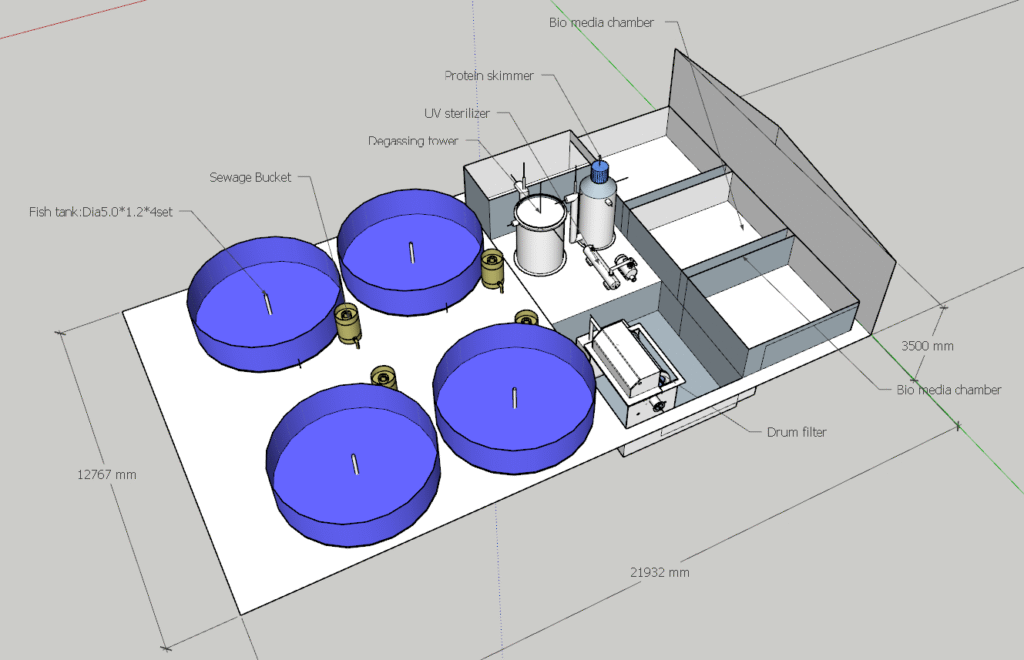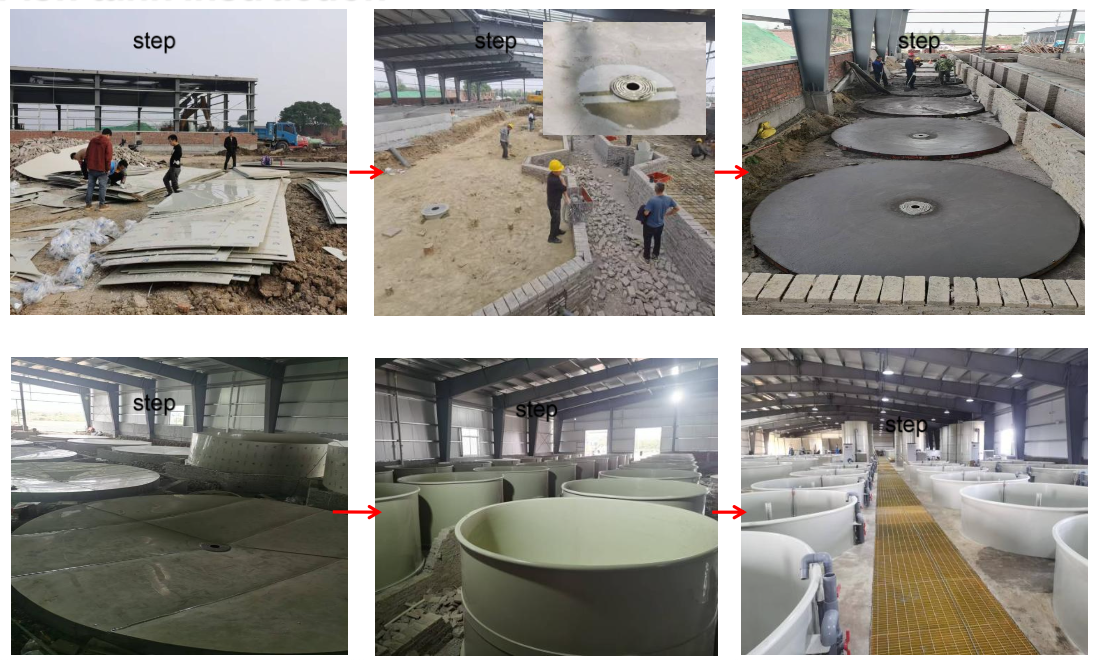RAS (Recirculating Aquaculture System)

🌊 ระบบเพาะเลี้ยงสัตว์น้ำแบบหมุนเวียน (RAS)
ใช้น้ำน้อย • ควบคุมคุณภาพได้ • เลี้ยงได้ตลอดปี
RAS คืออะไร?
RAS (Recirculating Aquaculture System) คือระบบเพาะเลี้ยงที่ นำน้ำกลับมาใช้ซ้ำ 90–99% โดยผ่านกระบวนการกรองของเสีย กำจัดแอมโมเนีย และฆ่าเชื้อ ก่อนส่งน้ำกลับเข้าบ่อเลี้ยงหรือตู้เลี้ยงอีกครั้ง
- ✅ ควบคุมคุณภาพน้ำได้ตลอด
- ✅ เลี้ยงหนาแน่นได้มากขึ้น
- ✅ ลดความเสี่ยงจากโรค
- ✅ ใช้น้ำใหม่เพียงเล็กน้อยต่อวัน
เหมาะกับ: ฟาร์มกุ้ง ฟาร์มปลา บ่อเพาะพันธุ์ โรงเพาะฟัก ห้องทดลอง และธุรกิจเลี้ยงสัตว์น้ำคุณภาพสูงใกล้เมือง
ระบบทำงานอย่างไร?
- บ่อเลี้ยงสัตว์น้ำ → กุ้ง/ปลาปล่อยของเสียและแอมโมเนีย
- กรองของแข็ง → ดรัมฟิลเตอร์/ไมโครฟิลเตอร์ แยกตะกอนออก
- กรองชีวภาพ (ไบโอฟิลเตอร์) → เปลี่ยนแอมโมเนีย (NH₃/NH₄⁺) → ไนไตรต์ (NO₂⁻) → ไนเตรต (NO₃⁻)
- คอลัมน์กำจัดก๊าซ → ลด CO₂, N₂ ปรับสมดุล pH
- ฆ่าเชื้อ/ขัดน้ำใส → ด้วย UV หรือโอโซน
- เติมออกซิเจน → โดยโคนออกซิเจน (Oxygen cone) หรือนาโนบับเบิล
- ควบคุมอุณหภูมิและ pH → ด้วยฮีตเตอร์/ชิลเลอร์ และสารปรับสภาพ
- เติมน้ำใหม่เล็กน้อย → 1–10% ต่อวัน

ข้อดีของ RAS
- 💧 ประหยัดน้ำ กว่า 90%
- 🛡️ ปลอดภัยกว่า ควบคุมโรคได้ดี
- 🐟 การเจริญเติบโตดีกว่า น้ำเสถียร ลดความเครียด
- 🚚 เลี้ยงใกล้ตลาดได้ ลดการขนส่งไกล
- 🌡️ ควบคุมสภาพแวดล้อมได้ เช่น อุณหภูมิ ความเค็ม
ข้อจำกัดของ RAS
- 💰 ต้นทุนเริ่มต้นสูง ต้องลงทุนอุปกรณ์และระบบ
- ⚡ ใช้ไฟฟ้ามากกว่า ต้องมีเครื่องสำรองไฟ
- 👩🔬 ต้องมีความรู้/ทักษะ ในการดูแล
- 🧹 ต้องจัดการตะกอน และของเสียอย่างถูกวิธี
- 🧪 ไนเตรตสะสม ต้องระบายน้ำบางส่วนหรือใช้ระบบกำจัดไนเตรต
อุปกรณ์หลักในระบบ
- บ่อเลี้ยง: ทรงกลม/รางน้ำ หมุนเวียนดี
- กรองตะกอน: ดรัมฟิลเตอร์, ไมโครฟิลเตอร์
- โปรตีนสกิมเมอร์: แยกฟอง/อินทรีย์
- ไบโอฟิลเตอร์: MBBR, trickling
- คอลัมน์กำจัดก๊าซ: ลด CO₂
- UV/โอโซน: ฆ่าเชื้อโรค
- ระบบเติมออกซิเจน: Oxygen cone, นาโนบับเบิล
- ปั๊มน้ำ: มีเครื่องสำรอง
- ระบบเซนเซอร์: DO, pH, อุณหภูมิ, ORP
ค่าเป้าหมายคุณภาพน้ำ (ตัวอย่าง)
| พารามิเตอร์ | ค่าแนะนำ |
| DO | 6.0–8.0 mg/L |
| TAN (แอมโมเนีย) | < 1.0 mg/L |
| NO₂⁻ | < 0.2 mg/L |
| NO₃⁻ | < 100 mg/L |
| CO₂ | < 15–20 mg/L |
| pH | 7.0–8.0 |
| อุณหภูมิ | คงที่ตามชนิดสัตว์น้ำ |
คำถามที่พบบ่อย (FAQ)
ถาม: ต้องเปลี่ยนน้ำทุกวันเท่าไหร่?
ปกติ 1–10% ต่อวัน เพื่อควบคุมไนเตรต
ถาม: ใช้กับกุ้งโตได้ไหม?
ได้ แต่ควรมีระบบเสริมกำจัดไนเตรต และจัดการคราบชีวภาพ (biofouling)
ถาม: โอโซนปลอดภัยไหม?
ปลอดภัยเมื่อควบคุมระดับ ORP และมีระบบทำลายโอโซนส่วนเกิน
ถาม: ต้องมีเครื่องเติมอากาศไหม ถ้ามีออกซิเจนแล้ว?
ต้องมี เพื่อช่วยผสมและกำจัด CO₂
สรุป
ระบบ RAS เหมาะสำหรับฟาร์มที่ต้องการ คุณภาพสูง ควบคุมง่าย ใกล้ตลาด ถึงแม้ลงทุนเริ่มต้นสูง แต่ช่วยเพิ่มผลผลิต ลดความเสี่ยง และประหยัดน้ำในระยะยาว
เรียนรู้เรื่องคุณภาพน้ำ จาก Link
Clean water. Stable growth. Lower footprint.
What is RAS?
RAS recycles 90–99% of water by filtering solids, converting toxic ammonia to nitrate, and polishing water before returning it to tanks. Result: high stocking density, biosecurity, and year-round production near markets.
Who uses it: shrimp hatcheries & nurseries, finfish (tilapia, trout, salmon, seabass), broodstock, research labs, premium live seafood.
How RAS Works (Step-by-Step)
- Culture Tanks – Fish/shrimp produce solids + ammonia.
- Solids Removal – Drum/microfilter or settling tank captures feces & feed fines.
- Biofiltration (Nitrification) – Media hosts bacteria that convert NH₃/NH₄⁺ → NO₂⁻ → NO₃⁻.
- Degassing – Strips CO₂ and nitrogen; stabilizes pH and fish respiration.
- Disinfection/Polishing – UV and/or ozone reduce pathogens and improve clarity.
- Oxygenation – Pure O₂ via oxygen cone or nanobubbles maintains target DO.
- Temperature & pH Control – Heaters/chillers, buffers.
- Make-up Water – 1–10% per day (or less with denitrification).
- Automation – Sensors (DO, pH, ORP, temperature, flow, level) with alarms.
Tip: For shrimp, add protein skimmer (foam fractionator) early to remove fine organics and reduce biofilter load.
Core Components (Quick Guide)
- Culture tanks: circular or raceway; strong turnover to push waste to center drain.
- Mechanical filter: drum/micro-screen (60–100 µm typical).
- Protein skimmer: removes fine organics; boosts ozone efficiency.
- Biofilter: MBBR (moving bed), trickling, or bead; size by TAN load (g/day).
- Degasser: packed column or cascade.
- UV/Ozone: pathogen control; ozone requires ORP safety and off-gas destruct.
- Oxygen system: oxygen cone / diffusers / nanobubbles; emergency backup O₂.
- Pumps & plumbing: redundancy + bypass; low head loss saves energy.
- Monitoring/SCADA: DO, pH, ORP, Temp, NH₃/NH₄⁺ (ion selective), NO₂⁻, salinity.
Benefits (Pros)
- Water saving: 90–99% less than flow-through.
- Biosecurity: easier pathogen control (inlet treatment, closed loop).
- Growth & FCR: stable water → better feed efficiency.
- Location flexibility: closer to markets; lower transport mortality.
- Environmental control: temp/salinity year-round.
Limitations (Cons)
- Capex & complexity: higher upfront cost; trained operators needed.
- Power demand: continuous pumping, oxygenation, controls.
- Risk concentration: failures (power, oxygen, biofilter crash) can escalate quickly → must plan redundancy.
- Waste handling: captured sludge requires disposal or treatment.
- Nitrate management: partial water exchange or denitrification stage.
Sizing & Design Basics (Plain English)
- Stocking & Biomass: define target kg/m³ and peak biomass.
- TAN Load: feed × protein × excretion factor → sizes biofilter (g TAN/day).
- Hydraulics: recirculation turnover 3–6×/h (species-dependent).
- Oxygen: size O₂ system to peak demand + 30–50% safety margin.
- Redundancy: N+1 pumps/blowers, backup oxygen, generator, alarms (SMS/app).
- Sanitation: smooth piping layout, isolation valves, clean-in-place (CIP) access.
Want a quick calculator? I can build you a small Google Sheet / Excel that converts feed rates → TAN → biofilter volume + oxygen demand.
Water Quality Targets (Typical)
| Parameter | Typical RAS Range |
| DO | 6.0–8.0 mg/L (species-specific) |
| TAN (NH₃/NH₄⁺ as N) | < 1.0 mg/L (lower is better) |
| Nitrite (NO₂⁻-N) | < 0.2 mg/L (with Cl⁻ management if needed) |
| Nitrate (NO₃⁻-N) | < 100 mg/L (manage by exchange/denit.) |
| CO₂ | < 15–20 mg/L (degassing) |
| pH | 7.0–8.0 (buffering/alkalinity) |
| Temperature | Species-specific stability |
Disinfection Options in RAS
- UV-C: low cost, no residual; needs clear water.
- Ozone: strong oxidant; improves clarity; requires safety controls.
- Cold plasma / PAW: emerging; combines oxidation + potential disinfection; higher energy & capex today.
- Biosecurity SOPs: footbaths, inlet filters, quarantine tanks, feed/storage hygiene.
Energy & Operating Cost Tips
- Use low-head pumps, big-radius bends, short pipe runs (reduce friction).
- Keep solids removal early & effective → saves biofilter and oxygen costs.
- Choose variable-speed drives (VFDs) to match flow to biomass stage.
- Heat-recovery or insulation where temp control is pricey.
RAS vs Pond/Flow-Through (At a Glance)
| Factor | RAS | Pond/Flow-through |
| Water use | 🔹 Very low | 🔸 High |
| Biosecurity | 🔹 High | 🔸 Medium/Low |
| Capex | 🔸 High | 🔹 Low |
| Opex (power) | 🔸 Medium–High | 🔹 Low–Medium |
| Skills required | 🔸 Higher | 🔹 Lower |
| Location | 🔹 Near city/market | 🔸 Often rural/coastal |
Education Topics (Blog/Knowledge Hub ideas)
- “RAS 101” – the full loop explained (downloadable PDF).
- Biofilter deep dive – seeding, cycling, preventing nitrite spikes.
- Ozone vs UV – when to use which (with ORP setpoints).
- Oxygenation methods – oxygen cone vs nanobubbles vs diffusers.
- Emergency response – DO crash playbook, backup O₂ checklists.
- Water chemistry for shrimp RAS – salinity, alkalinity, pH control.
- Sludge management – thickening, composting, value recovery.
- Costing a pilot RAS – CAPEX/OPEX templates and ROI thinking.
Frequently Asked Questions
Q1: How much water do I change daily?
Typically 1–10% depending on nitrate control and species.
Q2: Can RAS work for shrimp grow-out?
Yes—many run hatchery/nursery in RAS, and grow-out with partial exchange or denitrification to manage nitrate and biofouling.
Q3: Is ozone safe for shrimp/fish?
Yes, when controlled: monitor ORP (e.g., 250–320 mV in contact loop) and ensure off-gas destruct before water returns to tanks.
Q4: Do I still need aeration if I use pure oxygen?
Yes—mixing/degassing still needed for CO₂ removal and uniform DO.
Q5: What sensors are essential?
DO, temperature, pH, ORP, and level/flow at minimum; add NH₃/NO₂⁻ for tighter control